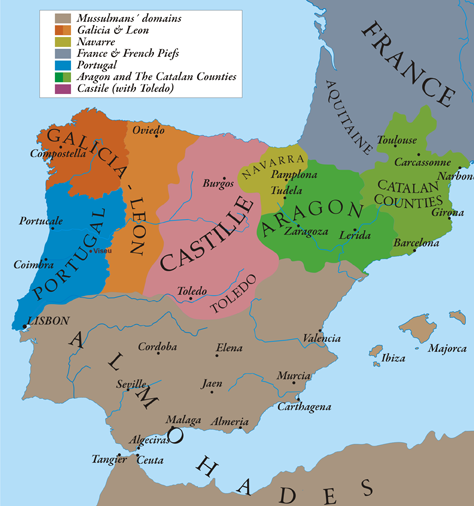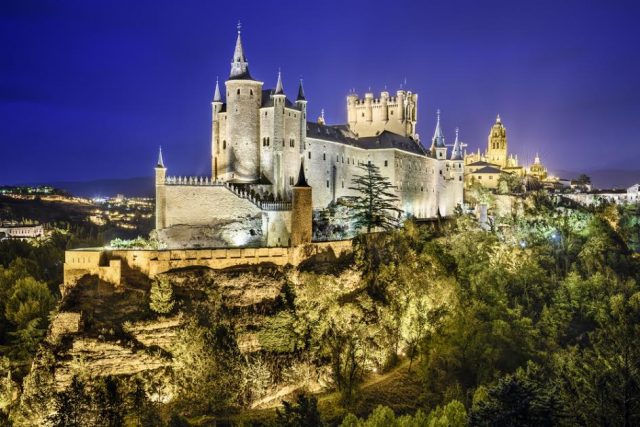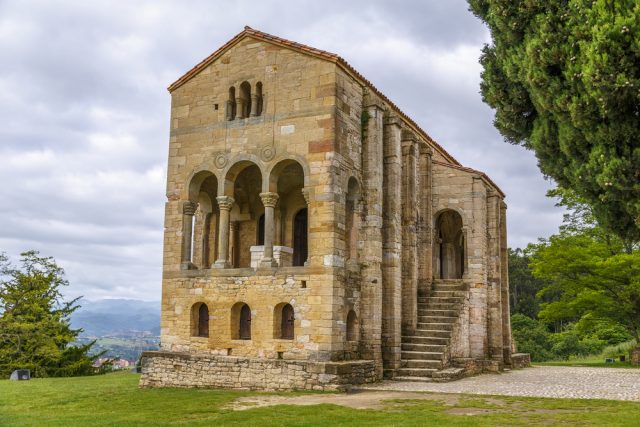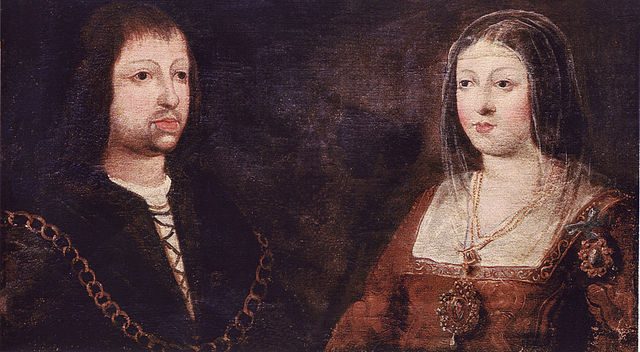Like a number of other European countries, modern Spain has its roots in history going back millennia. But more immediately, it all came together from a patchwork of kingdoms of the Middle Ages which shaped the unified kingdom which emerged in the 15th century. Here’s a vastly boiled-down overview of that complex history.
These kingdoms emerged from the 300-year period of rule (early 5th to early 8th century) of the Visigoths (Germanic invaders from the north) who took over from the Roman Empire, during which the institutions and culture (including Roman Hispania’s Christian religion and vulgate Latin language) evolved and in many cases diversified, particularly linguistically, into languages which are still vibrant today, such as Catalan and Galician (Basque is not Latin-derived and is a remnant of the culture of the prehistoric, pre-Indo-European peoples of Europe). This process of evolution continued for nearly another eight centuries while most of the Iberian peninsula was Al-Andalus, under Muslim rulers from North Africa.
The first of the kingdoms of Spain per se could be said to be the Kingdom of Asturias, formed when the last pocket of Christians up on the northern Bay of Biscay coast defeated an Islamic army in 722, then helped their neighbours in Galicia do the same. The Asturians spoke (and a good number still speak) Asturianu, a tongue very closely related to today’s Castilian Spanish, while Galician arose as something akin to a hybrid of Castilian and Portuguese.
 Alexander Vigo/University of Texas
Alexander Vigo/University of Texas
As in the rest of Iberia and Europe, the Kingdom of Galicia with its capital in still hugely atmospheric Santiago de Compostela, waxed and waned, sometimes alternating between independence and being part of other kingdoms, including Asturias, León, and Castile. The Kingdom of León was founded by the Asturians in 910 AD and its capital moved from Oviedo down to the city of León, today a lovely, lively, and historic city where you can still see remnants of that era. Over the course of the 11th and 12th centuries this kingdom joined with the next-door Kingdom of Castile to become Castile-León, and its language, Llionés, waned (sadly, it’s now nearly extinct).
This Kingdom of Castilla-León ultimately became the cultural and political core of the later Kingdom of Spain, by virtue of political alliances and monarchical marriages, as well as absorbing neighbouring kingdoms along with various emirates, caliphates, and taifas of Muslim Al-Andalus to its south.
Alongside Castile was the Kingdom of Aragon, previously part of the Basque Kingdom of Navarre, which then expanded via conquest of Muslim territories and dynastic union to rule the Principality of Catalonia, the Kingdom of Majorca, and the Kingdom of Valencia (it also came to rule domains beyond Iberia, including Sicily, Corsica, Sardinia, Malta, Naples/southern Italy, and even parts of Greece; more about them in a future post). One of the pivotal events of Spanish history, however, was the 1474 marriage of Ferdinand of Aragón with Isabella of Castile, which led to a united Kingdom of Castile and Aragón which became the nucleus of modern Spain, absorbing other domains (including the Kingdom of Navarre), and in 1492 completing the Reconquest of the peninsula from the Muslims and sending Christopher Columbus forth on his voyages of discovery in the Americas.
The history of Europe is packed with kingdoms, principalities, duchies, and other domains that over nearly two millennia sometimes dizzyingly waxed and waned, conquered/expanded, and were conquered/absorbed. The legacy of all these machinations turned out somewhat differently in Spain than they did in other modern European countries such as Germany, France, Italy, and the Netherlands. Here the cultural and political legacy of the kingdoms that came together to form Spain lives on in the system of autonomous communities established by the constitution of 1978 – the interplay of which still plays a major ongoing role in contemporary Spanish history.
This is the second in an occasional series of Love2Fly posts talking about key aspects of Spain’s long and complex history, to provide at least a bit of context for our travel, food, and culture posts, as well as simply to help our non-Spanish passengers and friends learn more about our fascinating country. Previous in series: The Real Pirates of the Caribbean. Next up: a look back at Spain’s current royal dynasty, the Bourbons.




